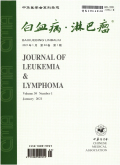MLL-AF4融合基因阳性初治急性淋巴细胞白血病患者临床特征及预后分析
Analysis of clinical characteristics and prognosis of newly-treated acute lymphoblastic leukemia patients with MLL-AF4 fusion gene-positive
摘要目的:探讨MLL-AF4融合基因阳性在初治急性淋巴细胞白血病(ALL)中的发生情况,分析MLL-AF4融合基因阳性ALL患者的临床特征及预后情况。方法:回顾性分析驻马店市中心医院2010年2月至2021年2月收治的455例原发初治ALL患者的临床资料。采用荧光原位杂交检测患者是否存在MLL基因重排,采用多重巢式反转录聚合酶链反应检测患者MLL-AF4融合基因阳性发生情况,比较MLL-AF4融合基因阳性与阴性患者的临床特征及预后。结果:455例原发初治ALL患者中,MLL基因重排阳性30例(6.6%),其中MLL-AF4融合基因阳性21例(MLL-AF4阳性组),MLL-ENL融合基因阳性6例,MLL-AF9融合基因阳性2例,MLL-AF10融合基因阳性1例。随机选取同期未检出任何融合基因的60例ALL患者作为MLL-AF4阴性组。MLL-AF4阳性组的肝或脾大、中枢神经系统(CNS)侵犯者比例及中位外周血白细胞计数、中位外周血幼稚细胞绝对值均高于MLL-AF4阴性组(均 P<0.05)。MLL-AF4阳性组与阴性组化疗第15天完全缓解率分别为81.0%(17/21)、90.0%(54/60)( χ2=0.49, P=0.484),3个月累积复发率分别为38.1%(8/21)、13.3%(8/60)( χ2=4.56, P=0.033)。MLL-AF4阳性组总生存差于MLL-AF4阴性组( χ2=5.93, P=0.015)。 结论:MLL-AF4融合基因阳性ALL患者较阴性患者初诊时肿瘤负荷高,复发率高,总生存率低,预后较差。
更多相关知识
abstractsObjective:To investigate the development of MLL-AF4 fusion gene-positive in newly-treated acute lymphoblastic leukemia (ALL) and to analyze the clinical characteristics and prognosis of patients with MLL-AF4 fusion gene-positive ALL.Methods:The clinical data of 455 patients with primary newly-treated ALL from February 2010 to February 2021 in Zhumadian Central Hospital were retrospectively analyzed. Fluorescence in situ hybridization was used to detect the presence of MLL gene rearrangement, and multiplexed nested reverse transcription polymerase chain reaction was used to detect the development of MLL-AF4 fusion gene-positive, and to compare the clinical characteristics and prognosis of patients with positive and negative MLL-AF4 fusion gene.Results:Among 455 patients with primary newly-treated ALL, 30 cases (6.6%) were positive for MLL gene rearrangement, including 21 positive for MLL-AF4 fusion gene (MLL-AF4 positive group), 6 cases positive for MLL-ENL fusion gene, 2 cases positive for MLL-AF9 fusion gene, and 1 case positive for MLL-AF10 fusion gene. A total of 60 ALL patients without any detection of fusion gene during the same period were randomly selected as the MLL-AF4-negative group. The proportion of those with hepatomegaly or splenomegaly, central nervous system (CNS) invasion, and the median peripheral blood leukocyte count and median peripheral blood na?ve cells absolute value in the MLL-AF4-positive group were higher than those in the MLL-AF4-negative group (all P < 0.05). The complete remission rates on day 15 of chemotherapy were 81.0% (17/21) and 90.0% (54/60), respectively in the MLL-AF4-positive group and MLL-AF4-negative group ( χ2 = 0.49, P = 0.484), and the cumulative relapse rates of 3 months were 38.1% (8/21) and 13.3% (8/60), respectively in the MLL-AF4-positive group and MLL-AF4-negative group ( χ2 = 4.56, P = 0.033). The overall survival in the MLL-AF4-positive group was worse than that in the MLL-AF4-negative group ( χ2 = 5.93, P = 0.015). Conclusions:Patients with MLL-AF4 fusion gene-positive ALL have a higher tumor load, a higher recurrence rate, a lower overall survival rate, and a poorer prognosis compared with negative patients at the initial diagnosis.
More相关知识
- 浏览0
- 被引0
- 下载0


相似文献
- 中文期刊
- 外文期刊
- 学位论文
- 会议论文



 换一批
换一批 换一批
换一批



